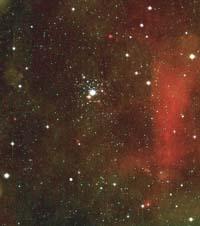Giant gaseous planets grow fast

Researchers at the Harvard-Smithsonian Astrophysics Center have shown that the creation of gaseous giants like Jupiter was rapid, investigating other stars. This was explained at the January meeting of the American Society of Astrophysics.
To illustrate this, the stellar cluster NGC 2362, 5 million years old, was analyzed. In this way, astronomers discovered that all the stars that are of the mass of the Sun or greater have lost their protoplanar discs. These discs supply raw materials to the gaseous giants in training process. For this reason, they concluded that the gaseous giants are formed in less than five million years.
However, many stars of the NGC 2362 keep their dart discs, a sign that they have not formed gas giants. According to the researchers, this means that in this stellar cluster bodies like Earth, Mars and Pluto can still be in formation.
In fact, according to Scott Kenyon of the Harvard-Smithso-Harvard Astrophysics Center, Earth spent 20-30 million years to achieve its last mass, but Jupiter was completely formed in two or three million a year.





